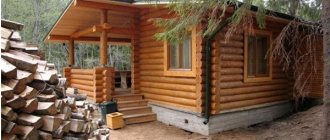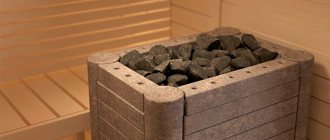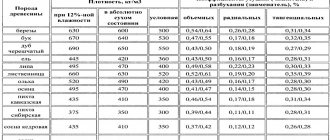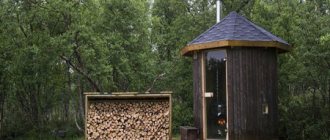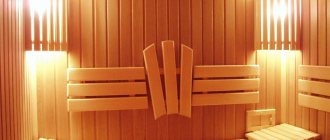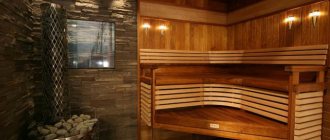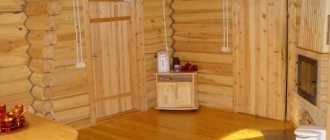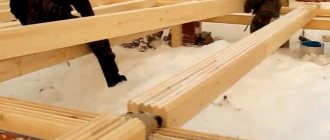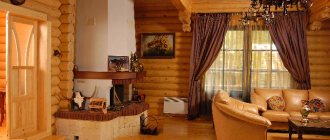Lining is a universal material, used mainly for interior work. The cost of this building material varies depending on its quality. Before you begin installing the lining, you should make the necessary calculations of its quantity, for which you can use an online calculator, or know how to calculate the lining yourself.
A convenient and simple calculator for calculating the amount of lining: https://otdelkaexp.ru/kalkulyatory-rascheta/kalkulyator-rascheta-vagonki-dlya-sten-po-ploshhadi.html.
Wood selection
Today, the construction market is filled with a variety of options for finishing materials, so for a beginner in repair and construction, choosing lining can be a serious challenge.
The main thing that a buyer must go to the market with is the concept of the exact value of the required amount of material. This approach will help prevent some uncomfortable situations. After all, buying extra materials leads not only to a loss of money, but also time for its possible return.
Important! When choosing wooden lining, special attention should be paid to the type of wood from which it is made. The most common options are deciduous and coniferous wood.
Let's look at the types of trees most commonly used in lining production:
- Pine. It is distinguished by high strength indicators, which attracts consumers. However, you need to know that pine lining quickly loses its original color if it is not treated with protective varnish or stain.
- Oak. The beautiful structure of the wood, which practically does not rot, makes this lining a leader in the ranking of the popularity of finishing materials. Its only drawback is the high price, which is not affordable for everyone.
- Ash. It is not used very often because processing such wood is quite labor-intensive and costly. But at the same time, ash wood is very durable and does not change its structure and shape when dried.
- Linden is an ideal option for arranging steam rooms in a bathhouse or sauna. It retains heat perfectly without emitting resin oils that are harmful to human health.
What do you need to know about lining?
In the distant past, owners of large stone houses lined the walls with beautiful carved wood panels. Today, the decoration has become somewhat simpler, carving is no longer in fashion, and living spaces are sheathed in the same way that passenger cars were sheathed quite recently - with smooth tongue-and-groove boards. Actually, this is where the name of the material came from – lining. But it looks very beautiful, even noble, if it is made of high-grade wood, such as oak, beech or cedar. The finishing with clapboard made of alder, spruce, as well as linden and aspen looks very aesthetically pleasing.
For some, the use of oak panels of the “Extra” class may seem too expensive, and the grades “A”, “B” and, especially, “C” do not cause delight, due to the presence of cracks and knots, albeit in small quantities. In this case, it’s worth remembering about an alternative option made of plastic. Panels made of PVC from Russian manufacturers and imported additives necessary to stabilize the extrusion process look no worse than wood, although they are inferior in strength
.
Each material has pros and cons: PVC is cheaper, but is easily deformed and short-lived; more expensive wood lasts longer only with careful care.
Types of wood
The quality of the lumber and, as a consequence, the final appearance of the product, significantly affects the price of the lining.
There are four main types of wood that can affect the cost:
- category "Extra". This is the highest class of wood, which has no knots, cracks or other defects on its surface;
- class “A” is assigned to wood that can have one or two knots per linear meter of board;
- class “B” assumes that there are dark-colored defects on the surface of the wood, up to 1 cm in diameter;
- class “C” is assigned to the lowest quality wood from which lining of the appropriate price and quality is produced.
It is not difficult to calculate the required amount of material. If any difficulties arise, the seller of the product will always come to the rescue. The main thing is to make all calculations on time, before the transaction is completed. This will help save money and prevent a situation where a very large amount of trim remains after repairs.
Of course, there should be a supply of lining, but within reasonable limits. As a rule, experts recommend adding 10-15% of the reserve to the calculated value of the required amount of material.
Important! When choosing a forcing, take into account the functional purpose of the room where the finishing work will take place.
How to make the necessary calculations?
If you decide to sheathe the inside of a bathhouse or house, then you will definitely need a full calculation of the lining and its quantity.
First, determine what type of material is right for you: wood or plastic. These are personal preferences, the square footage of the rooms will not change in any way. Product sizes vary:
| Type | Thickness (mm) | Width(cm) | Length (m) |
| Wooden | 12-25 | up to 15 | until 6 |
| Plastic | up to 12 | up to 30 | until 6 |
First, find out the main parameters of the room where finishing is planned: height, length and width. Next, the area of the walls is calculated. Afterwards, the values are added up - this will be the number of linings.
Important! They buy a little more lumber, because it gets damaged during the work.
To calculate the amount of building material for individual elements, the area is divided by the width of the lamella. This minimizes lumber waste.
What units are the lining sold in?
Lining is mainly sold by cubic meters, which can create some inconvenience when calculating the required amount of material. For greater convenience, it is worth remembering approximately how much area a lining of a certain size can cover:
- a panel whose dimensions are 6000*200*8 mm will occupy an area of 1.2 m2;
- if the lining parameters are 6000*250*5, then the area size will be 1.5 m2;
- a panel with dimensions 2600*148*6 will cover an area of 7.07 m2.
As you can see, the dimensions of the material take into account the thickness indicator. If the lining is sold individually, then the thickness indicator has no meaning and is not used when performing the calculation.
However, in the case of selling material in units of volume, the thickness parameter has a significant impact on the final result when calculating the required amount of lining.
We calculate the lining per m2
If it is not possible to use an online calculator, then you should use basic knowledge of geometry and spend a little time. For example, we use a standard room with the following dimensions:
- Length – 8 m.
- Width – 5 m.
- Height – 2.35 m.
The sequence for calculating the amount of wood paneling is as follows:
- Find out the area of all the walls in the room. First, you should calculate the longest wall and multiply by 2. To do this: 8 m must be multiplied by 2.35 m and multiplied by 2. Answer: 37.6 m2 is the total area of \u200b\u200bthe two walls.
- Next, we find the area of the smaller walls: multiply 5 m by 2.35 m and multiply by 2. Answer: 23.5 m2.
- The total area of the walls of the room will be: 37.6 m2 plus 23.5 m2. Answer: 61.1 m2. But we should not forget about such an important parameter as the surface area of the ceiling, which is equal to the area of the floor. Calculation: multiply 8 m by 5 m, answer – 40 m2. This means that the total area that needs to be covered with clapboard will be 101.1 m2.
Video on Youtube:
For greater accuracy, you should make a small margin, for example, a couple of square meters on top. And the final answer will be 103-105 m2. This amount of wood paneling is quite enough to cover a room with the above parameters.
Of course, the data obtained is quite enough to purchase the required amount of lining. But the lining is sold in the form of separate boards, with certain dimensions, and a situation may arise when a hardware store needs to name the exact number of these same strips, and not the total square footage. To calculate the number of lining strips, you should find out the size of one, which is 6 m by 0.15 m. The standard thickness of one board is 2.5 cm, but this parameter is most often not used, because the area is calculated, not the volume.
The surface area of one board is 0.9 m2. It remains only 105 m2 divided by 0.9 m2, which will be equal to 117 (rounding up 116.6) pieces of wood paneling.
Calculation of the amount of lining
The amount of lining is calculated using the following algorithm:
Determine the total area for cladding:
S = (2AN + 2VN) – ( ahn + bh 1 n 1) , where A is the length of the room; H – room height; B is the width of the room; a – window width; b – door width; h, h1 – window and door height; n, n1 – number of windows and doors.
If the ceiling area is taken into account, the calculation formula is as follows:
S= (2AH + 2BH +AB) – (ahn + bh1n1).
We determine the area of the lining for the attic, the ceiling of which is represented by two surfaces and a vertical front without bulkheads:
S = 2 AB + 2 b (4 A 2- b 2)/4 , where A is the distance from the ridge to the base of the slope.
If you need to calculate the amount of lining for an attic with bulkheads, the formula is as follows:
Area = 2AB + 2b (4A2-b2)/4 + Ph, where P is the perimeter of the bulkheads, h is the height of the wall.
You can calculate the area of one panel using simple mathematical calculations. To determine the area of one panel, you need to multiply the length of this panel by the width. In the result obtained, it is necessary to subtract the area of the groove, which is not an element of the skin surface.
To calculate the required amount of material in pieces, you need to divide the total area of the cladding by the area of one panel.
Calculations can be carried out manually, but this process, as a rule, takes a fairly large amount of time and effort. Special computer programs for online calculators will help speed it up and make it easier. As practice shows, the final values when using this method will not differ significantly from those that would be obtained by manual calculation.
Measuring room parameters
The length and width of the room (assuming smooth walls) are measured along the floor, along the corner or baseboard. It is better to measure the height of the room along the angle between the walls. When measuring the height and width of windows, you do not need the height of the frame or transom itself, but the slopes. It is easy to measure the width along the window sill, the height - from the bottom plane of the window sill up to the horizontal slope.
The door parameters should also be measured not by the leaf, but by the distance between the sides of the opening (between the door frame or already installed finishing parts - it all depends on how the sheets will be mounted).
How to calculate the area of the first floor
It is better to consider the algorithm for calculating the area of a room using the example of a 5x8 house, where we will cover the walls and ceiling with clapboard.
Next you need to calculate the square footage of one of the rooms. Let its length (a) be 5m, width (b) 4m, and height (c) 2.5m. And then everything was as we were taught in the school geometry course.
- Let's start with a long wall: multiply its height by length (ac) = 5x2.5 = 12.5 m2.
- The opposite wall will be the same size, so we simply multiply the result by two. 12.5x2=25 sq. m.
- Now, using the same principle, we find the size of the smaller wall (bc) = 4x2.5 = 10 square meters. Multiply by two. 10x2=20 sq. m.
- We multiply the length of the room by its width and get the ceiling area (ab) = 5x4 = 20 square meters.
- Let's summarize the data obtained from points 2, 3 and 4. And in addition, the square footage for finishing one room is 25 + 20 + 20 = 65 square meters.
Using the same principle, we find the parameters of the remaining rooms and summarize. In this case, the second room had the same dimensions, so the area of the entire first floor is: 65+65=130 square meters.
